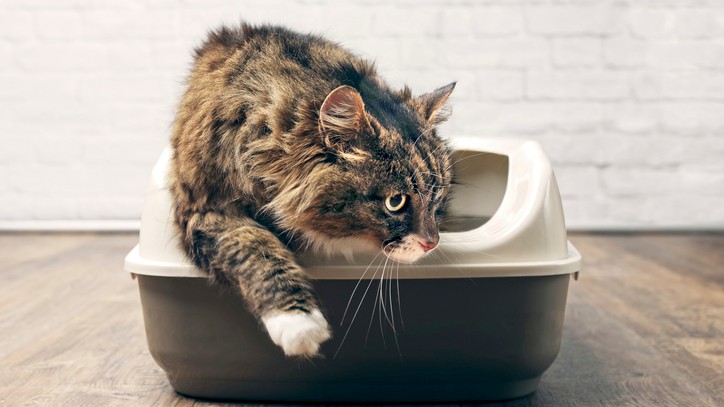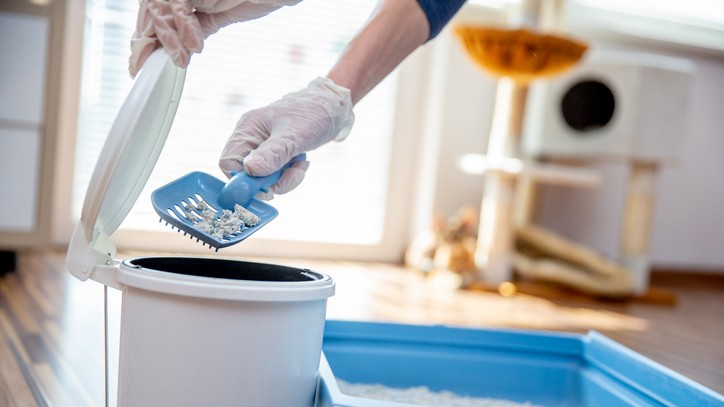How to treat urinary tract infections in cats
Urinary tract infections in cats are no joke, here's what you can do to diagnose and treat them quickly and easily

It is essential to have urinary tract infections in cats appropriately diagnosed and treated. Many pet owners are all too familiar with the pungent scent of cat urine from a cat that has suddenly started urinating outside the litter box! In fact, litter box issues are one of the most common reasons why cats are surrendered to shelters every year. And while inappropriate urination is frustrating to deal with, it is often just one symptom of a much larger health issue. So before you pull out the carpet shampooer yet again, check out these tips for identifying and treating urinary tract infections in cats.
Symptoms of urinary tract infections in cats
One of the first symptoms of urinary tract infection that pet owners will notice is their cat urinating outside the litter box. Many pet owners are quick to dismiss this as the cat simply misbehaving or “acting out”, but it is important not to ignore this sudden change. Often, inappropriate urination is the only sign of a problem. In some cases, the cat may also experience other symptoms, such as:
- Blood in the urine
- Straining to urinate
- Frequent trips in and out of the litter box
- Vocalizing while urinating
- Urinating frequent small volumes
- Fever
- Decreased appetite
Male cats are particularly prone to urinary blockage, which is a life-threatening condition. If your cat is exhibiting severe symptoms such as straining without producing urine, lethargy, or pain, seek veterinary care immediately.
Is it really a urinary tract infection?
Although urinary tract infections are often easy to spot, other conditions can have similar symptoms. Bladder stones, for example, can cause your cat to develop blood in the urine, straining, and inappropriate urination. Conditions that make your cat urinate more frequently, such as diabetes mellitus or chronic kidney disease, can also result in inappropriate urination and frequent trips to the litter box. Litter box management issues, such as a box that is dirty or hard to access, can also lead to inappropriate urination.
Feline Lower Urinary Tract Disease (FLUTD) – also known as sterile cystitis, chronic interstitial cystitis, or Pandora syndrome – is another common condition that can cause symptoms almost identical to a urinary tract infection. Cats with FLUTD often experience recurrent bouts of inflammation within the urinary bladder, resulting in symptoms such as blood in the urine, inappropriate urination, and frequent urination. The difference between FLUTD and a UTI is that a cat with FLUTD does not have an infection – there are no bacteria or other organisms present in the urine and treatment with antibiotics is unlikely to be beneficial.
Because so many other conditions can cause similar symptoms, it is very important to see your veterinarian to have the problem appropriately diagnosed and treated. You might also want to take a look at Is my cat sick?. Your vet will perform a physical examination and will likely want to perform a urinalysis to assess your cat’s urine for signs of infection. Your veterinarian may also recommend blood work or radiographs (x-rays) to rule out other conditions such as bladder stones or kidney disease. Although these diagnostic tests can be expensive, they are essential to ensure that your cat receives the proper course of treatment, ensuring you have the best pet insurance will help to guard against the costs.
Treating urinary tract infections in cats
If your cat is diagnosed with a urinary tract infection, your veterinarian will prescribe antibiotics to treat the infection. Depending on the severity of your cat’s symptoms, your veterinarian may also prescribe anti-inflammatory medications, pain control medications, or fluids to help alleviate some of your cat’s symptoms. It is very important to follow your veterinarian’s instructions and complete the full course of antibiotic treatment to resolve the infection.
Get the best advice, tips and top tech for your beloved Pets
In some cases, your cat may develop an infection that is resistant or continues to come back despite antibiotic treatment. When this happens, your veterinarian may recommend performing a test called a urine culture. To do this, a sample of your cat’s urine is submitted to a laboratory, where the bacteria will be multiplied (cultured) and identified. This then allows the lab to test several different antibiotic medications on the bacteria to determine which treatment(s) are most effective against the infection. This is an important diagnostic step to address infections that are resistant to the typical first-line antibiotic treatments.

Preventing urinary tract infections in cats
Good litter box management is crucial to managing urinary issues in cats. Cats who dislike the litter box are more likely to urinate outside of it and may hold their urine for extended periods of time, which can predispose them to developing urinary tract infections. Your cat should have at least two litter boxes in separate locations and they should be cleaned at least once a day and filled with the best cat litter you can afford. The boxes should be located in quiet, low-traffic areas of the house, away from noisy appliances or other obstacles that may deter your cat. If you have more than one cat in the household, a good rule of thumb is to have at least one litter box per cat, plus one extra. This ensures that there is always a litter box available whenever a cat needs it, and prevents one cat from bullying the others by blocking access to the box.
Stress management is also an important consideration when attempting to prevent or address urinary issues in cats. Cats with FLUTD, in particular, are very prone to urinary flare-ups when stressed. Although cats often appear to be the picture of relaxation, many cats experience chronic stress and anxiety. Cats are not humans, and small changes that may seem innocuous to us – like moving the food bowl to a new location or adding a new pet to the household – can be very disruptive to your cat. Bullying and inter-cat aggression in multi-cat households can also be a significant source of stress. Providing plenty of environmental enrichment, using calming pheromones like Feliway, and minimizing changes and disruption can help prevent future urinary issues for your cat. If necessary, your veterinarian can also prescribe medication to help manage your cat’s anxiety and prevent future flare-ups.
Urinary tract infections in cats: A complex problem
Urinary problems in cats are often a complex issue with multiple contributing factors. In addition to treating the infection with prescription medications under your veterinarian’s guidance, addressing external factors such as stress and litter box management will also be necessary. With the right combination of medication and management, many cats will return using the litter box, giving their owners a sigh of relief – and a breath of fresh air!
You might also want to read: Why is my cat peeing outside the litter box?
Dr. Elizabeth Racine is a small animal general practice vet covering all things pet health and wellness. Her special interests include veterinary behavior, nutrition, and internal medicine.
As a freelance writer, Dr. Racine has written content for major companies in the industry such as the American Kennel Club, Merck Animal Health, Bayer PetBasics, Elanco, and CareCredit. In her free time, Dr. Racine enjoys playing trampoline dodgeball, hiking with her beagle Dasher, and spending time with her three mischievous cats.

